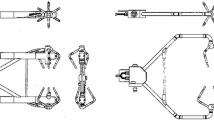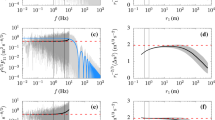Abstract
The speed of sound in moist air is discussed and a more accurate value for the coefficient of the linear dependence of sonic temperature on specific humidity is proposed. An analysis of speed-of-sound data measured by three sonic anemometers in a climate chamber and in the field shows that the temperature response of each instrument significantly influences not only the determination of sonic temperature, but also its fluctuations. The corresponding relative contribution to the error in the evaluation of the temperature fluctuations and the turbulent heat fluxes can be as high as 40%. The calibration procedure is discussed and a method of correction is proposed.
Similar content being viewed by others
References
Actis A, Fernicola VC (1999) A reference instrument for accurate measurements of air temperature. In: Proceedings of 15th world congress of the international measurement confederation (IMEKO XV), Osaka, Japan, vol 7, pp 191–196
Actis A, Banfo M, Fernicola VC, Galleano R, Merlo S (1998) Metrological performances of the IMGC two-temperature primary humidity generator for the temperature range −15° to 90°. In: Proceedings of 3rd international symposium on humidity and moisture, Teddington, UK, vol 1, pp 2–9
Actis A, Fernicola VC, Banfo M (1999) Characterisation of the IMGC frost point generator in the temperature range −75° to 0°. In: Proceedings of Tempmeko ’99, Delft, The Netherlands, vol 1, pp 185–190
Barrett EW, Suomi VE (1949) Preliminary report on temperature measurement by sonic means. J Meteorol 6: 273–276
Cramer O (1993) The variation of the specific heat ratio and the speed of sound in air with temperature, pressure, humidity and CO2 concentration. J Acoust Soc Am 93: 2510–2516
Ferrero E, Anfossi D, Richiardone R, Trini Castelli S, Mortarini L, Carretto E, Muraro M, Bande S, Bertoni D (2009) Urban turbulence project. The field experimental campaign. Internal Report ISAC-TO/02-2009, pp 1–37
Foken T, Wichura B (1996) Tools for quality assessment of surface-based flux measurements. Agric For Meteorol 78: 83–105
Greenspan M (1987) Comments on ‘Speed of sound in standard air’ [J. Acoust. Soc. Am., 79, 1359–1366 (1986)]. J Acoust Soc Am 82:370–372
Hignett P (1992) Corrections to temperature measurements with a sonic anemometer. Boundary-Layer Meteorol 61: 175–187
Högstrom U, Smedman A (2004) Accuracy of sonic anemometers: laminar wind-tunnel calibrations compared to atmospheric in situ calibrations against a reference instrument. Boundary-Layer Meteorol 111: 33–54
Iribarne JV, Godson WL (1981) Atmospheric thermodynamics. Geophysics and Astrophysics Monographs. Reidel, Dordrecht, 259 pp
Ishii C (1935) Supersonic velocity in gases. Sci Pap Inst Phys Chem Res Tokyo 26: 201–207
(1975) Standard atmosphere. ISO 2533-1975, Geneva, 108 pp
Kaimal JC, Businger JA (1963) A continuous-wave sonic anemometer-thermometer. J Appl Meteorol 2: 156–164
Kaimal JC, Gaynor JE (1991) Another look at sonic thermometry. Boundary-Layer Meteorol 56: 401–410
Lemmon EW, Jacobsen RT, Penoncello SG, Friend DG (2000) Thermodynamic properties of air and mixtures of nitrogen, argon, and oxygen from 60 to 2000 K at pressures to 2000 MPa. J Phys Chem Ref Data 29: 331–385
Liu H, Peters G, Foken T (2001) New equations for sonic temperature variance and buoyancy heat flux with an omnidirectional sonic anemometer. Boundary-Layer Meteorol 100: 459–468
Loescher HW, Ocheltree T, Tanner B, Swiatek E, Dano B, Wong J, Zimmerman G, Campbell J, Stock C, Jacobsen L, Shiga Y, Kollas J, Liburdy J, Law BE (2005) Comparison of temperature and wind statistics in contrasting environments among different sonic anemometer-thermometers. Agric For Meteorol 133: 119–139
Mortensen NG (1994) Wind measurements for wind energy applications - a review. In: Wind Energy Conversion. In: Proceedings of the 16th British Wind Energy Association conference, Stirling, Scotland, 15–17 June 1994, pp 353–360
Richiardone R, Giampiccolo E, Ferrarese S, Manfrin M (2008) Detection of flow distortions and systematic errors in sonic anemometry using the planar fit method. Boundary-Layer Meteorol 128: 277–302
Schotanus P, Nieuwstadt FTM, De Bruin HAR (1983) Temperature measurement with a sonic anemometer and its application to heat and moisture fluxes. Boundary-Layer Meteorol 26: 81–93
Sonntag D (1990) Important new values of the physical constants of 1986, vapour pressure formulations based on the ITS-90, and psychrometer formulae. Z Meteorol 70: 340–344
Sonntag D (1998) The history of formulations and measurements of saturation water vapour pressure. In: Proceedings of 3rd international symposium on humidity and moisture, Teddington, UK, vol 1, pp 93–102
Trusler JPM (1991) Physical acoustics and metrology of fluids. Adam Hilger, Bristol, 255 pp
Wagner W, Pruss A (2002) The IAPWS formulation 1995 for the thermodynamic properties of ordinary water substance for general and scientific use. J Phys Chem Ref Data 31: 387–535
Wexler A (1976) Vapor pressure formulation for water in range 0 to 100°. A revision. J Res Natl Bur Stand 80A: 775–785
Wexler A (1977) Vapor pressure formulation for ice. J Res Natl Bur Stand 81A: 5–20
Wong GSK, Embleton FW (1985a) Experimental determination of the variation of specific heat ratio in air with humidity. J Acoust Soc Am 77: 402–407
Wong GSK, Embleton FW (1985b) Variation of the speed of sound in air with humidity and temperature. J Acoust Soc Am 77: 1710–1711
Zuckerwar AJ (2002) Handbook of speed of sound in real gases vol III—speed of sound in air. Academic Press, Amsterdam, 290 pp
Author information
Authors and Affiliations
Corresponding author
Rights and permissions
About this article
Cite this article
Richiardone, R., Manfrin, M., Ferrarese, S. et al. Influence of the Sonic Anemometer Temperature Calibration on Turbulent Heat-Flux Measurements. Boundary-Layer Meteorol 142, 425–442 (2012). https://doi.org/10.1007/s10546-011-9688-z
Received:
Accepted:
Published:
Issue Date:
DOI: https://doi.org/10.1007/s10546-011-9688-z




